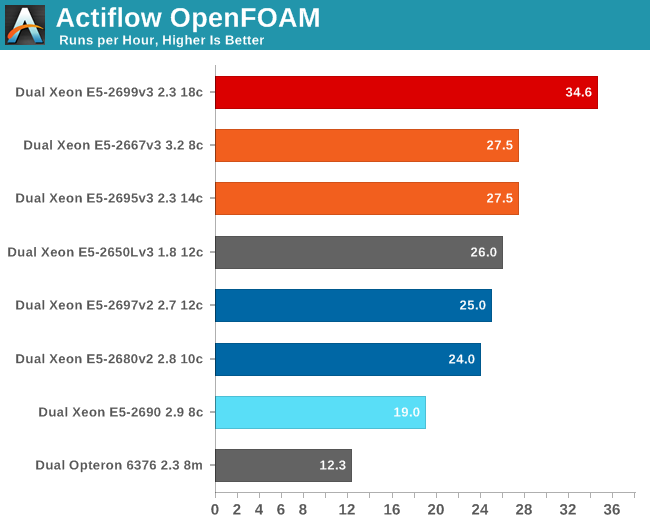Intel Xeon E5 Version 3: Up to 18 Haswell EP Cores
by Johan De Gelas on September 8, 2014 12:30 PM ESTOpenFoam
Computational Fluid Dynamics is a very important part of the HPC world. Several readers told us that we should look into OpenFoam, and my lab was able to work with the professionals of Actiflow. Actiflow specializes in combining aerodynamics and product design. Calculating aerodynamics involves the use of CFD software, and Actiflow uses OpenFoam to accomplish this. To give you an idea what these skilled engineers can do, they worked with Ferrari to improve the underbody airflow of the Ferrari 599 and increase its downforce.
We were allowed to use one of their test cases as a benchmark, but we are not allowed to discuss the specific solver. All tests were done on OpenFoam 2.2.1 and openmpi-1.6.3.
Many CFD calculations do not scale well on clusters, unless you use InfiniBand. InfiniBand switches are quite expensive and even then there are limits to scaling. We do not have an InfiniBand switch in the lab, unfortunately. Although it's not as low latency as InfiniBand, we do have a good 10G Ethernet infrastructure, which performs rather well. So we can compare our newest Xeon server with a basic cluster.
We also found AVX code inside OpenFoam 2.2.1, so we assume that this is one of the cases where AVX improves FP performance. To understand this real world test case better, we'll start with a single-threaded benchmark.

As this is AVX code, the clock speed "rules" change. A 2.3GHz Xeon E5 v3 can fall back to 1.9GHz if necessary, but it may also boost to 3.3GHz if the thermals allow it. The Xeon 2695 v3 has less TDP headroom and as a result it performs slightly slower than the Xeon E5-2699 v3. Still they cannot beat the Xeon E5-2667 v3 in single-threaded HPC performance. The latter is the better chip for this workload as it guarantees 2.7GHz and can boost up to 3.5GHz. As the previous Xeons also support AVX and run between 2.7 and 3.3GHz, they keep up with the Xeon E5-2667 v3.
Of course, most HPC code is now multi-threaded. We next ran OpenFOAM at one thread per physical core, which is about 5% faster than running with one thread per logical core (likely due to AVX).

If you work professionally with OpenFOAM, it is clear that it pays off to understand what a certain CPU offers. If money does not matter much, the Xeon E5-2699 v3 does what is has to, which is to beat everybody else despite the fact that OpenFOAM does not scale that well beyond a certain point.
To give you an idea of what we're seeing, with 16 threads on the Xeon E5-2699 v3 we were already running at 30 runs per hour. Despite the fact that our workload is already a pretty heavy one (>600k cells), it is clear you need a larger mesh to really use the best Xeons of today to their full potential.
A less expensive option is the Xeon E5-2667 v3, but the real winner here is the Xeon E5-2650L v3 which costs a full $1000 per CPU les than the Xeon E5-2695 v3 and consumes quite a bit less as we will see on the next page.










85 Comments
View All Comments
cmikeh2 - Monday, September 8, 2014 - link
In the SKU comparison table you have the E5-2690V2 listed as a 12/24 part when it is in fact a 10/20 part. Just a tiny quibble. Overall a fantastic read.KAlmquist - Monday, September 8, 2014 - link
Also, the 2637 v2 is 4/8, not 6/12.isa - Monday, September 8, 2014 - link
Looking forward to a new supercomputer record using these behemoths.Bruce Allen - Monday, September 8, 2014 - link
Awesome article. I'd love to see Cinebench and other applications tests. We do a lot of rendering (currently with older dual Xeons) and would love to compare these new Xeons versus the new 5960X chips - software license costs per computer are so high that the 5960X setups will need much higher price/performance to be worth it. We actually use Cinema 4D in production so those scores are relevant. We use V-Ray, Mental Ray and Arnold for Maya too but in general those track with the Cinebench scores so they are a decent guide. Thank you!Ian Cutress - Monday, September 8, 2014 - link
I've got some E5 v3 Xeons in for a more workstation oriented review. Look out for that soon :)fastgeek - Monday, September 8, 2014 - link
From my notes a while back... two E5-2690 v3's (all cores + turbo enabled) under 2012 Server yielded 3,129 for multithreaded and 79 for single.While not Haswell, I can tell you that four E5-4657L V2's returned 4,722 / 94 respectively.
Hope that helps somewhat. :-)
fastgeek - Monday, September 8, 2014 - link
I don't see a way to edit my previous comment; but those scores were from Cinebench R15wireframed - Saturday, September 20, 2014 - link
You pay for licenses for render Nodes? Switch to 3DS, and you get 9999 nodes for free (unless they changed the licensing since I last checked). :)Lone Ranger - Monday, September 8, 2014 - link
You make mention that the large core count chips are pretty good about raising their clock rate when only a few cores are active. Under Linux, what is the best way to see actual turbo frequencies? cpuinfo doesn't show live/actual clock rate.JohanAnandtech - Monday, September 8, 2014 - link
The best way to do this is using Intel's PCM. However, this does not work right now (only on Sandy and Ivy, not Haswel) . I deduced it from the fact that performance was almost identical and previous profiling of some of our benchmarks.